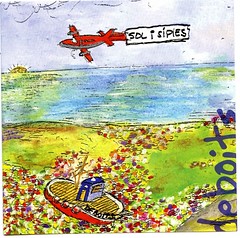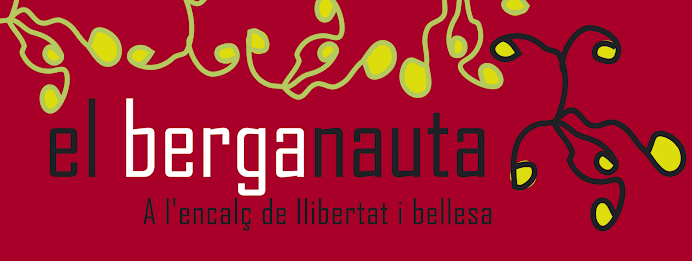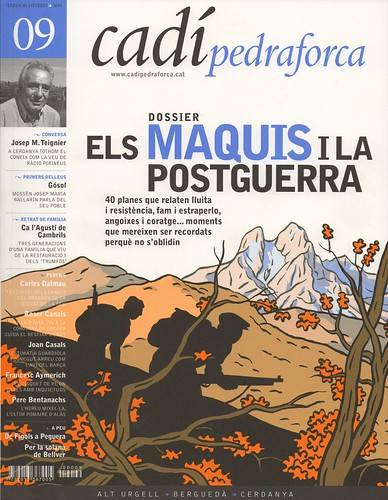La revista Metropolitan Barcelona, en anglès i de lliure distribució, acaba de publicar el número del mes de novembre 2010.
Un article de tres pàgines, signat per Tara Stevens, està dedicat a la febre boletaire dels catalans. El Berguedà hi surt especialment recomanat.
A continuació us oferim l'article sencer.
Fungi foraging
It's mushroom season and there are plenty of places to head if you want to pick your own.
To get an idea of just how obsessive a sport the boletaire (wild mushroom hunting) is you need only look on Facebook. On it you will find innumerable groups among them simply ‘Bolets’ (wild mushrooms) which has 535 fans scattered across Catalunya, each as secretive as the other when it comes to prime hunting grounds. A love of the mushroom they may share, but you can be sure they don’t reveal its whereabouts. And yet, throughout the autumn you’ll see carloads of folk heading out of the city and into the hills in the hope of finding this most elusive of gourmet treasures. As the late great Catalan gourmand and writer Manuel Vázquez Montalbán put it, the best reason to go mushroom picking is that it’s one of the few things left in the world that is free. Add to that the thrill of a tramp through the fallen leaves, a slap up lunch in the country and maybe a night in a stone masia with some friends, a bottle of wine and a crackling fire and this mushroom hunting caper starts to seem like a rather good idea. There is good mushroom hunting ground all over Catalunya, but the Berguedà region must surely be its capital. The area is said to have more than 1500 different species (for culinary purposes, hunters generally select from the 30 or so tastiest varieties) sprouting from its damp, dark forests and hedgerows. On any given weekend through the autumn, all along the old Catharist trail known as the Camí dels Bons Homs (the Path of Good Men), which runs from the Montségur Castle in Berga to Tarascon on the French side of the Pyrenees, it’s all about the shrooms: the biggest, the prettiest and the tastiest just like the prize vegetable contest in farmers’ festivals everywhere. You’ll spot the boletaires too, crouched furtively beneath clusters of trees clutching muddied wicker baskets, traipsing nonchalantly through ditches and generally doing their best to look inconspicuous. One of the distinctive traits of the wild mushroom is that they tend to colonise the same area year after year, and the secret locations of these are passed from generation to generation by those that collect them. Top tip then: once you’ve got your special patch of rovellons, don’t give it up.
A less competitive kind of sport can be enjoyed at the annual Mercat del Bolet de Guardiola de Berguedà. Think of it as Catalunya’s equivalent to the truffle market of Alba, albeit considerably less expensive, where pickers, sellers and buyers trade a variety of mushrooms from €8 to €30 a kilo. The market takes place daily from 1st September through 30th November and includes competitions, tastings and cooking courses as well as the usual communal feasting typical of Spanish festivals.
Nothing really beats the thrill of the chase though and if you’re remotely nervous about going it alone, there are several guides in the region, contactable through local tourist offices, who’ll show you the ropes and help you safely identify your pickings. The Generalitat (www.gencat.com) also has a good general introduction to mushroom season on its website, citing useful information such as how to pick them (cut them at ground level and gather them in baskets not bags to ensure the spores continue to flourish in the forest) plus a guide to what’s what.
Know your mushrooms
When it comes to gathering mushrooms the rule is; if in doubt, leave it alone. People die every year from ingesting poisonous species. That said, few things are more satisfying that sitting down to a plate of wild mushrooms that you picked yourself, lightly grilled and dressed with a pat of fresh, yellow butter. So seek carefully and enjoy.
Ou de Reig, the romantically named ‘royal egg’ is the king of the autumn with its chestnut like cap and pretty yellow gills. If slowly roasted, whole, it makes a perfect partner to lightly grilled ducks’ liver sprinkled with sea salt.
Llenega (wax cap) proliferates in the Bages region from September to December. Its cap is the colour of arbequina olives and can grow up to 10cms across, with milky white gills. You’ll find it beneath pine trees in low mountain areas.
Ceps (porcini) are easily recognisable by their dark flesh and plump, dumpling like bodies. The taste is mild, but shaved like truffles and drizzled with a fruity olive oil they make the most delicate carpacchio.
Rovellons (bleeding white cap) emerge in early September and last through December. They are perhaps the most revered species in Catalunya, with a pretty tawny colour that unfortunately is easily confused with highly poisonous species. The surest way to know is when you cut the stem, the wine-coloured liquid that comes out quickly turns a sludgy green. They are at their best sautéed very lightly in butter and served as a side to something hearty like polenta and pork chops. Note many of the rovellons you see in the markets are imported from the huge, industrial farms of Soria, and may not be quite so ‘wild’ as they first appear.
Pinetells (delicious milk cap mushrooms) are aptly named as one of the tastiest of the crop. They are distinguished by the orange milk that, like the rovelló, turns green soon after cutting. It can grow up to 15cms in diameter with a cap like Saturn: think red and orange concentric circles dotted with green. The stem is white with orange spots and it grows everywhere from the coast to the Pyrenees, from late August to early January. Because of its size, it’s a good choice for popping on the griddle with a little oil and garlic and serving as a starter, or in a sandwich with a juicy steak.
Múrgoles (morels) are probably the most distinctive looking mushroom of all with their conical, honeycomb caps. Lately, every time I’ve had them, they seem to come in a foie and cream sauce, which I must confess, I’ve so far failed to improve on.
Fredolics (grey knight mushrooms) have a short season from September to November and are distinguished by bluish-grey colouring. The cap is knobbly, the gills a dirty white colour. It thrives in pine forests and comes out in force after a cold snap, so you might want to keep an eye on those temperatures. However it can be easily confused with a seriously poisonous variety, the spotted tricholoma, which is bigger with a scaly cap. If the stem is very spotty, don’t pick it. The Fredolic stem is generally spot-free. Eating-wise I’m not a big fan, but it does have its place among aficionados.
The Carlet (panther cap) is a pretty, rose coloured mushroom with Bordeaux blushes over the cap. It has a good meaty flesh and is sweetish, providing it isn’t picked too big when it gets bitter. It thrives in oak and beech forests through September and October and lends itself well to bottling and preserving rather than eaten fresh. It’s the Carlet that you’ll see in brine or vinegar in jars and it makes a useful addition to winter stews and game dishes.
Camagrocs or rossinyols (fleshy, peachy-hued chanterelles) grow between August and October. They thrive in pine forests particularly in the mossy areas at the foot of the tree. They grow in clusters, are trumpet-shaped with gills turned inside out in the all the colours of the sunset. They are very difficult to mistake and therefore one of the best marks for amateur boletaires. They are however the worst culprits for going slimy, so don’t overcook.
Trompetes de la Mort (black trumpets, trumpets of death or horn of plenty) far from being deadly are delightful in a creamy pasta sauce. They are in season from August through December and look just like black chanterelles so they are difficult to mistake. Another good hunting opportunity for amateurs.
Where to stay
The Molí del Casó is an old water mill converted into a smart B&B, located a few kilometres north of Berga. Built of local stone and wood it is heated by solar panels and an existing hydroelectric system, making it a good choice for eco-foodies. Most of the food in the restaurant comes from their herb (edible and medicinal), fruit and vegetable gardens and eggs from their own hens. They also organise cooking workshops and cheese and local wine tastings if you don’t feel up for the hunt.
Molí del Casó
Barri Terradellas 10, Bagà
Tel. 93 824 40 76
www.molidelcaso.es
Top three restaurants for bolets
Never let it be said that bolets are anything other than gourmet. Berga is a hive of high-end restaurants all of which specialise in mushroom dishes through the seasons.
Els Casals
Earned a star for chef Oriol Rovira’s inspired cooking. Everything is grown and reared in house.
Els Casals
Sagàs - Tel. 93 825 12 00
www.hotelelscasals.com
Restaurant la Cabana
A rather posh country inn, popular among the elusive boletaire during mushroom season for a slap up lunch.
Nr. Berga - Tel. 93 821 04 70
www.lacabanaberga.com
Restaurant Sala
This restaurant has a reputation for churning out some of the best and most inventive mushroom dishes around.
Berga - Tel. 93 821 11 85
www.restaurantsala.com
Podeu accedir a Metropolitan Barcelona clicant
aquí



